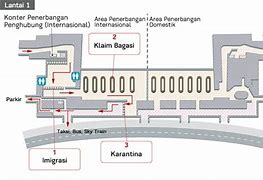
Inter-terminal transfer
Inter-terminal transfer is available on the landside (before security). Free shuttle buses between terminals 1, 2 and 3 are available. The Skytrain people mover system also connects all terminals. The headway of the Skytrain is 5 minutes, with 7 minutes needed to transfer from Terminal 1 to Terminal 3.[30] There is no inter-terminal transfer options in the transit area/airside.
Bus services including the state-owned Perum DAMRI and other private companies provide services from the airport to various destinations in Greater Jakarta and other adjacent areas.[31] The buses operate from 06.00 to 23.00.
The Soekarno-Hatta Airport Rail Link is connected through the Skytrain system. The railway service connects the airport to the city centre of Jakarta.[32]
To make sure to access the checkout page, you must allow your location in the browser.
Online order available: Free shipping and returns, Secure Payment, Exclusive online services
To make sure to access the checkout page, you must allow your location in the browser.
Online order available: Free shipping and returns, Secure Payment, Exclusive online services
Jepara bumi kartini, kemanapun aku pergi, pasti pulang kepelukanmu. Kangen pasti ada, meskipun orang lain bilang JEPARA itu kota kecil
ABSTRAK. Bandar Udara Internasional Soekarno-Hatta merupakan pintu gerbang ke berbagai negara/daerah maka bentuk bangunan terminal penumpang dapat memberikan ciri khas atau identitas atau karakter visual bagi kawasan bandar udara dan memberikan keindahan saat dilihat dari sisi udara dan sisi darat. Terminal penumpang merupakan bangunan yang dapat menampilkan karakter visual bandar udara. Karakter visual dapat dirasakan oleh setiap pengguna bandar udara yang terlihat pada fasad bangunan. Fasad pada Terminal Penumpang bandar udara memiliki peranan penting dalam mempresentasikan dan memudahkan masyarakat untuk mengenal Bandar Udara sebagai ciri khas kawasan , sehingga fasad terminal penumpang perlu dikaji elemen-elemennya yang dapat menampilkan karakter bangunannya. Penulisan ini bertujuan mengidentifikasi elemen fasad pada bangunan terminal 1, terminal 2 dan terminal 3. Metode yang digunakan pada penulisan ini adalah metode kualitatif dengan mendeskripsikan karakter fasad bangunan terminal penumpang. Dari hasil analisis maka didapatkan karakter fasad bangunan terminal penumpang Bandar Udara Internasional Sooekarno-Hatta berupa atap, pintu, jendela dan ornament.
Kata kunci : fasad, terminal penumpang, bandar udara
ABSTRACT. Soekarno-Hatta International Airport is the gateway to various countries/regions, so the passenger terminal building's shape can provide characteristics or identities or visual character for the airport area and provide beauty when viewed from the airside and the side of the ground. The passenger terminal is a building that can display the visual character of the airport. The visual character can be felt by every airport user seen on the façade of the building. The facade of the airport Passenger Terminal has an essential role in presenting and making it easier for the public to know the airport as a characteristic of the area. The façade of the passenger terminal needs to be reviewed; its elements that can display the character of the building. This writing aims to identify the facade elements in terminal 1, terminal 2, and terminal 3. The method used in this paper is a qualitative method by describing the character of the façade of the passenger terminal building. From the results of the analysis, it is found that the character of the facade of the passenger terminal of Soekarno-Hatta International Airport in the form of roofs, doors, windows, and ornaments.
Keywords: façade, passenger terminal, the airport
Ground transportation
To make sure to access the checkout page, you must allow your location in the browser.
Online order available: Free shipping and returns, Secure Payment, Exclusive online services
International terminal in Banten, Indonesia
Soekarno–Hatta International Airport Terminal 3 is a terminal of Soekarno–Hatta International Airport serving Greater Jakarta, Indonesia. It is located on northeast side of the airport. Terminal 3 has a different style to other terminals of the airport. Terminal 1 and 2 were built with incorporation of the local Javanese architecture into the design, but Terminal 3 is built in contemporary modern design with a degree of environmental friendly and traditional sense. The terminal was first named as Terminal 3 Ultimate before it was renamed simply as Terminal 3.
Garuda Indonesia Group airlines, including Garuda Indonesia and Citilink, operate all of its flights from this terminal. Most foreign airlines and several local airlines serving the airport also fly from this terminal.[1][2] In 2017, the terminal was named as the best airport terminal in Indonesia at the ninth Bandara Awards initiated by Majalah Bandara.[3]
The former Terminal 3 was officially opened for commercial flights when Mandala Airlines and Indonesia AirAsia started operations in T3 for their domestic flights on 20 April 2009 followed by international flights on 15 November 2011. The old Terminal 3 had a capacity of 4 million passengers per annum, 30 check-in counters, 6 baggage carousels and 3 gates with two jet bridges. In 2012, Angkasa Pura II, the airport operator, undertook a master plan to upgrade Soekarno-Hatta International airport into a world class airport and ultimately build an Aerotropolis.[4] The expansion of Terminal 3 is part of the masterplan.[5][6] Terminal 3 was initially projected to serve 60 airplanes.[7]
The new Terminal 3 officially opened for commercial aviation on 9 August 2016 at midnight stroke of WIB.[8] At first, the new T3 had no link with the old T3 building. The old T3 is now renovated and connections between the new and old terminals have been built.[9] Airlines that belonged to SkyTeam alliance gradually moved from T2 to the new T3, starting with Garuda Indonesia on 1 May 2017, Saudia on 10 July, Vietnam Airlines on 12 July, Korean Air on 17 July, and XiamenAir on 30 July, respectively.[10][11] It was later announced that in December 2017, all international flights will be using the new T3.[12]
Terminal 3 is 1.2 kilometres long and the apron is able to serve 40 aircraft.[6] The terminal has the capacity to serve 25 million international passengers each year.[13] It was designed to cater as a transit point for international airlines. Spanning 422,804 square metres, the new terminal is slightly larger than Changi Airport's Terminal 3. It has 10 gates for international flights and 18 for domestic, 206 check-in counters, 38 self check-in and 12 bag drop counters, 59 aerobridges, four-star hotels, meeting rooms, duty-free shops, retail outlets, restaurants and multi-storey carparks.[14] Total area of the main building is about 331,101 square metres, the parking building 85,578 square meters and the VVIP building 6,124 square metres. The check-in area of the terminal is arranged in eight clusters. The terminal has an automated baggage handling system featuring at least 13 conveyor belts.[15] The parking area can accommodate 2,600 cars and 2,600 motorcycles.[16]
Terminal 3 is equipped with BHS level 5 to detect explosives and directly move them into security blankets, an Airport Security System (ASS) which can control up to 600 CCTVs to detect faces who are available in the security register. The terminal also has "Intelligence Building Management System" (IBMS) which can control uses of water and electricity, rain water system to produce clean water from rain, a recycled water system to produce flushing water from used toilet water, and illumination technology control to illuminate the terminal depending on the weather surrounding the terminal.[17]
Terminal 3 has WiFi access. The terminal has a Tourist Information Center (TIC) from where tourists may get information on tourist attractions, transportation, accommodation and other travel related information in Indonesia.[18]
Immigration facilities
As the terminal is extensively used for international flights, it has a large passport control hall, with staffed booths (for all passports) and autogates (for all Indonesian and eligible foreign passports).[22] There is also a visa-on-arrival facility for eligible visitors before passport control.[23]
Since its opening, the terminal has been plagued with numerous problems, ranging from long baggage wait times, insufficient and unsafe lighting, lack of proper signage, as well as having its car parks experience near continuous traffic jams.[24][25]
It also faced multiple criticisms on its design. The constructed terminal deviated considerably from the original design proposed by Woodhead Associates,[26] eliciting allegations that the contractors were cutting corners. The perceived lack of attention to the terminal's aesthetics has also led to criticisms. In 2022, the Minister of State-Owned Enterprises Erick Thohir publicly lamented the poor quality of the terminal's carpets.[27]
Another common complaint is the poor structuring of the terminal with long distances to gates and a lack of sufficiently-fast travelators.[28] The terminal is also not well-catered for handling international transit passengers.[29]
Terminal 3 is the airport's newest and largest terminal. This terminal is used as a hub for Garuda Indonesia and Citilink as well as Pelita Air and TransNusa. Here is the list of airlines currently and formerly serving the terminal.
Hotel and co-working space
There is a premium co-working space named as APSpace in the terminal. The co-working space has serviced offices, meeting rooms, event spaces, business lounges, high speed internet. and sleeping pods which is supported by advanced technologies.[19]
Terminal 3 also has a Digital Airport Hotel or capsule hotel with 120 rooms, which has Alpha-type and Beta-type rooms.[20]
A 4-star hotel, Anara Hotel, opened in 2020.
The commercial area of Terminal 3 covers an area of 71,225 square metres. This area is divided into several zones: food & beverages with an area of 23,301 square metres, retail 22,023 square meters, servicing 2,007 square metres, duty free 4,784 square metres, lounge 8,496 square metres, exhibition 1,493 square metres, and airline offices 19,121 square metres.[21]



